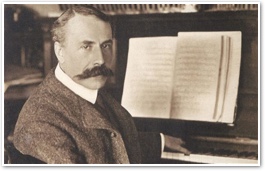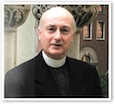Now that the hour is come
- FATHER GEORGE W. RUTLER
In these wistful autumnal days when the liturgical commemorations of All Saints and All Souls set the theme, that melody of "Nimrod" and the lines of Gerontius give a confused world a dose of reality.
 Sir Edward William Elgar
Sir Edward William Elgar1857-1934
The biographies of classical composers could give the impression that irregular behavior has been almost a necessary attribute of great talent. A particularly rank example is the uniquely inventive Renaissance composer of sacred music and madrigals, Carlo Gesualdo, Prince of Venosa, who murdered his wife and her lover, mutilated their corpses and exposed them naked in the town square. He was a nephew of Saint Carlo Borromeo. Beethoven was notorious for his domestic squalor and explosive temper, and Handel could fly off the handle at the sound of an ill-tuned cello. Purcell and Sibelius spent more time in taverns than in concert halls. The cleric Vivaldi was banned from Verona to protect its schoolgirls and Bruckner later indulged a similar attraction, along with a fascination with human skulls.
Wagner could not abide rooms with 45-degree corners, and insisted that they be hung with yellow perfumed silk. His cult of Nordic racism set a bad precedent. Many of his original scores were destroyed along with Hitler in the Berlin bunker and to this day his operas are not performed in Israel. Scriabin was of a different outlook, being a theosophist devotee of Madame Blavatsky. Schoenberg so suffered from triskaidekaphobia that he hid under his bedcovers on the thirteenth day of each month, unlike Wagner who thought the number could augur good as well as evil. Satie owned one hundred umbrellas and two grand pianos which he stacked one on top of the other. Mahler was so absentminded that he would stir his coffee with a cigarette.
On the other hand, Bach kept a happy household crammed with twenty children plus many students and was the trusty object of their affection. No one had a bad word for kindly "Papa" Haydn: a cheerful soul who prayed the Rosary for musical inspiration. If one didn't mind Mozart's sophomoric humor and what some scholars think may have been Tourette's syndrome, he was by all accounts a genial companion, as was Mendelssohn notwithstanding those infrequent fits when he would berate German relatives in an incoherent form of English. George Gershwin had a normal boyhood, playing stickball on the streets of Brooklyn until his parents bought a piano. And then there is the almost abnormal normalcy of the self-taught composer Sir Edward Elgar (1857-1934).
He was born in a placid village outside Worcester and cultivated an unaffected benignity that made him countless friends. William, his father, was a piano tuner and owned a sheet music shop, and played the violin well enough to perform in the Three Choirs Festival in Worcester. His mother Ann was the ample and amiable daughter of a farmer. Edward was the fourth of her seven children, whom she reared in the Catholicism to which she had converted. William disapproved of this, but only mildly since he was the paid organist in the Jesuit church of Saint George's in Worcester. His son would succeed him there. Today, the renovated organ still has the stops used by Edward, marked with an "E." The handsome church, which now belongs to the Archdiocese of Birmingham, has over the altar a large reproduction of Raphael's "Transfiguration," a gift in 1837 from the 16th Earl of Shrewsbury, John Talbot. The Catholic "Good Earl John" was revered for his munificence to the Church. The original Raphael work had been commissioned in 1517 by Cardinal Giulio de'Medici who, before becoming Pope Clement VII, had been titular bishop of Worcester.
As a young piano teacher, Elgar proposed marriage to his student Alice Roberts, who was fluent in five languages and eventually became a proficient author of poetry and novels. She was born in Gujarat, India where her father was a Major-General. Her family did not approve of a marriage beneath her station, especially to a Catholic since Alice's great grandfather, Robert Raikes, had founded the Sunday School system in the Church of England. The couple wed in London's Brompton Oratory,
Alice proved to be a mainstay in periods when her husband seemed unnoticed or even discouraged. Once when he was idly playing a few notes on the piano she said, "That's a pretty tune, Eddie — keep it." And so issued "Nimrod," the ninth of the "Enigma Variations." Each is a musical sketch of one of Elgar's unnamed friends. In the Old Testament, Noah's great-grandson was Nimrod, the "great hunter." So this ninth section was meant for the composer's advocate at the Novello publishing house, Augustus Jaeger, whose name means hunter in German. That variation's haunting solemnity has made it a set piece for countless memorial services and commemorations. It is played each Remembrance Day at the Cenotaph in Whitehall in the presence of the Sovereign. A choral setting of it uses a text from the Requiem Mass:
|
Lux aeterna luceat eis, |
May light eternal shine upon them, |
In 1900, two years after the "Enigma Variations" Elgar set to music Cardinal Newman's long poem, "The Dream of Gerontius." Elgar thought of it as a unique form and resisted calling it an "oratorio" even though such had sound ecclesiastical credentials from the days of the Oratory of Saint Philip Neri. It is about the deathbed struggle of a man trying to prepare his soul for the eternal habitations. Alice had given a copy of Newman's poem to Edward as a wedding present ("'til death do us part") and Dvorak had personally discussed with Newman the possibility of setting it to music. Parts of the text are, or should be, familiar hymns that justly occlude some of the banalities that pass today for funeral music with corpses flying off on Eagle's Wings.
There are, for instance, "Firmly I believe and truly…" and the mighty "Praise to the holiest in the height" which had already become popular hymns with different tunes.
Elgar and the Viennese violinist Fritz Kreisler greatly admired each other, and in 1910 Kreisler commissioned a violin concerto from him. After a chance encounter in New York in 1947, Monsignor Fulton Sheen, then a professor of philosophy at the Catholic University of America, instructed Kreisler and his wife and regularized their marriage. Sheen claimed them as converts, although this was not quite accurate since Kreisler, though of a Jewish ancestry, had long before been baptized. But Sheen visited them regularly and preached at their funerals. Elgar stopped composing after his wife died in 1920. At her funeral a quartet of his surviving friends played the Andante section of his E minor String Quartet, composed after so many of his other friends had not survived the Great War. Edward and Alice are buried next to their daughter in the churchyard of St. Wulstan's in Little Malvern, which now is in the care of the Benedictines of Downside Abbey.
Although Elgar considered his "Gerontius" to be his masterpiece, the first of Elgar's "Coronation Marches" is surely his best-known work, and rare has been a college graduation ceremony without it. Having written the marches in honor of Edward VII, Elgar himself became a symbol of the sturdiest heights of Edwardiana, and he physically resembled that other symbol of the age, Rudyard Kipling; their lives were virtually coterminous. The words for the "Land of Hope and Glory" march were written by Arthur Benson, brother of the convert preacher and author Monsignor Robert Hugh Benson. Elgar did not thirst for honors, but was not unsatisfied when George V made him a baronet and "Master of the King's Musick."
Performances of Elgar's "Gerontius" were banned in the Anglican cathedrals of Gloucester and Peterborough because of its Catholic theology of Purgatory. Hubert Parry appreciated the acoustics when he heard it for the first time in the yet unfinished Westminster Cathedral, but he sniffed: "…it reeks too much of the morbid and unnatural terrors and hysterics engendered by priestcraft to be congenial … vivid though it certainly is."
"Gerontius" means "old man" and represents Everyman, and the doctrines of Particular Judgment, Purgatory and the Intercession of the Saints, are blessings of God's grace for mortal souls. In these wistful autumnal days when the liturgical commemorations of All Saints and All Souls set the theme, that melody of "Nimrod" and the lines of Gerontius give a confused world a dose of reality. They are a sturdy relief from the depressing attempts of a secular culture to "celebrate life" artificially at funerals when in fact such awkwardness harbors a pagan fear of death. But as Newman wrote and Elgar played:
Now that the hour is come, my fear is fled;
And at this balance of my destiny,
Now close upon me, I can forward look
With a serenest joy.
 This is Meaghen Gonzalez, Editor of CERC. I hope you appreciated this piece. We curate these articles especially for believers like you.
This is Meaghen Gonzalez, Editor of CERC. I hope you appreciated this piece. We curate these articles especially for believers like you.
Please show your appreciation by making a $3 donation. CERC is entirely reader supported.

Acknowledgement
 Father George W. Rutler. "Now that the hour is come." From the Pastor (October 28, 2018).
Father George W. Rutler. "Now that the hour is come." From the Pastor (October 28, 2018).
Reprinted with permission from Father George W. Rutler.
The Author
 Father George W. Rutler is the pastor of St. Michael's church in New York City. He has written many books, including: The Wit and Wisdom of Father George Rutler, The Stories of Hymns, Hints of Heaven: The Parables of Christ and What They Mean for You, Principalities and Powers: Spiritual Combat 1942-1943, Cloud of Witnesses — Dead People I Knew When They Were Alive, Coincidentally: Unserious Reflections on Trivial Connections, A Crisis of Saints: Essays on People and Principles, Brightest and Best, and Adam Danced: The Cross and the Seven Deadly Sins.
Father George W. Rutler is the pastor of St. Michael's church in New York City. He has written many books, including: The Wit and Wisdom of Father George Rutler, The Stories of Hymns, Hints of Heaven: The Parables of Christ and What They Mean for You, Principalities and Powers: Spiritual Combat 1942-1943, Cloud of Witnesses — Dead People I Knew When They Were Alive, Coincidentally: Unserious Reflections on Trivial Connections, A Crisis of Saints: Essays on People and Principles, Brightest and Best, and Adam Danced: The Cross and the Seven Deadly Sins.




